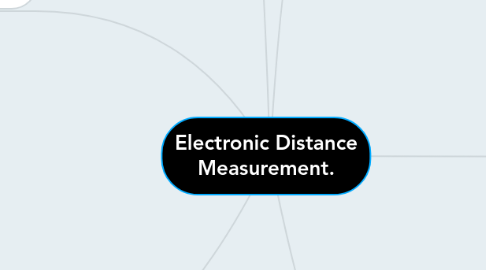
1. Advantage of EDM
1.1. line of sight instrument
1.2. capable of measuring long distance
1.3. reflectorless are single per on operation
1.4. the speed and accuracy in measurement
1.5. several obstacle to chaining are automatically overcome when these instrument are used
2. Disadvantage of EDM
2.1. the instrument is complicated to use
2.2. accuracy affected by atmospheric conditions
2.3. can be expensive
3. Uses of EDM
3.1. measuring distnace
3.1.1. operate instrument to measure the distance
3.1.2. an EDM is set over one point and a prism over the other
3.2. setting up distance between equipment
3.2.1. at a trial distance, measure a slope distance.(convey this information to chainman by hand signal or radio)
3.2.2. then move the prism to a new trial position. (when the prism is within 2-3m of its requiredd position, compute a horizontal distance)
3.2.3. measure the difference between trial and required position with a tape and move the prism to the new position
3.2.4. the distance can be checked and the ground markd as required.
3.3. measuring difference in height
3.3.1. proceed to measure the slope distance
3.3.2. with basic EDM the difference in height is calculated from (slope distance x sine of vertical angle)
4. These instrument rely on propagation of modulated light waves.
5. Types of EDM instrument
5.1. Microwave
5.1.1. Make use of microwaves.
5.1.2. Such instruments were invented as early as 1950 in South Africa by Dr. T.L Wadley and named theam as Tellurometers.
5.1.3. The instruments need only 12 to 24 V batteries.
5.1.4. They are light and highly portable.
5.1.5. Tellurometers can be used in day as well as in night.
5.1.6. The range of these instruments is up to 100km.
5.1.7. It consists of two identical units. One unit is used as master unit and the other as remote unit.
5.2. Infrared wave
5.2.1. In these instrument amplitude modulated infrared waves are used.
5.2.2. Prism reflectors are used at the end of line to be measured.
5.2.3. With these instruments accuracy achieved is +/- 10mm.
5.2.4. 800m-1km (singe prism)
5.2.5. The range of these instrument is up to 3km.
5.3. Light wave
5.3.1. These type of instrument was first developed in Sweeden and was named as Geodimeter
5.3.2. During night its range is up to 2.5 km while in day its range is up to 3 km.
5.3.3. Accuracy of these instrument varies from 0.5 mm to 5mm / km distance.
5.3.4. These instruments are also very useful for civil engineering projects.
6. Characteristics
6.1. distance range
6.1.1. These instruments are useful for most of the civil engineering works. The instruments are available in the trade names DISTOMAT DI 1000 and DISTOMAT DI 55
6.1.2. These instruments are light and economical and can be mounted on thedolite.
6.1.3. long-range EDM can be extended to 15km using II prisms
6.2. accuracy range
6.2.1. +/- (2mm +1ppm) for long-range EDM
6.2.2. +/- (5mm = 5ppm) for short-range EDM

